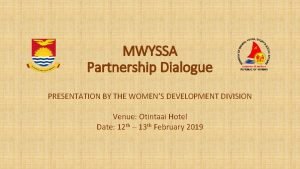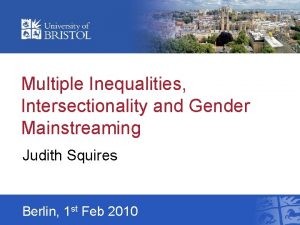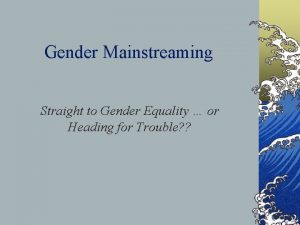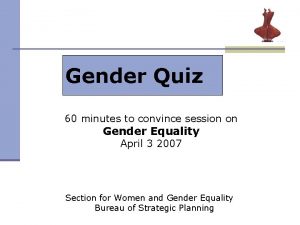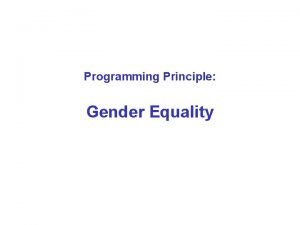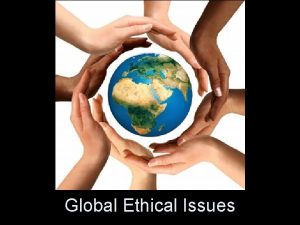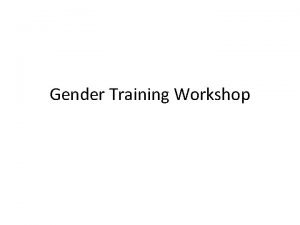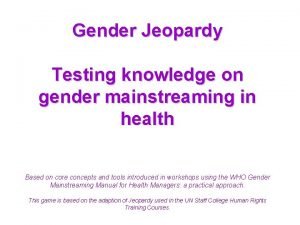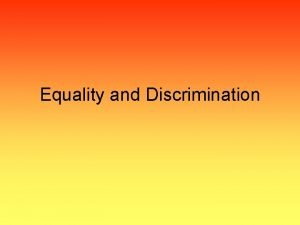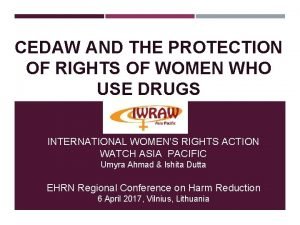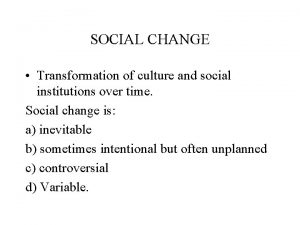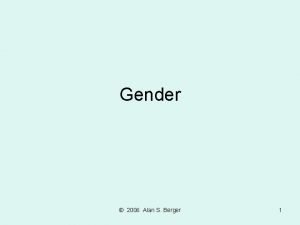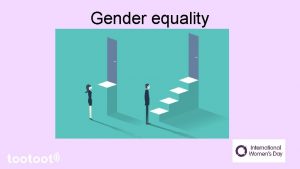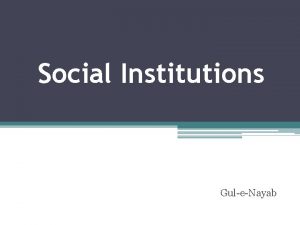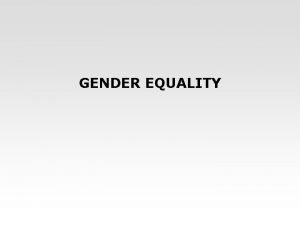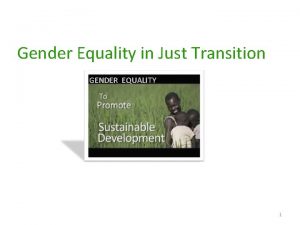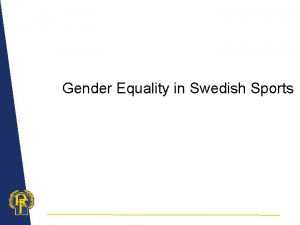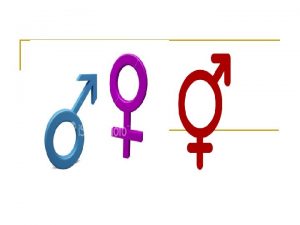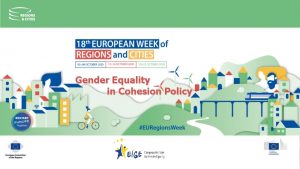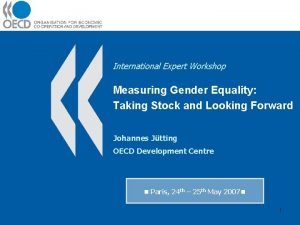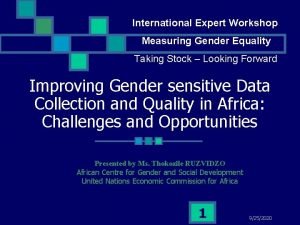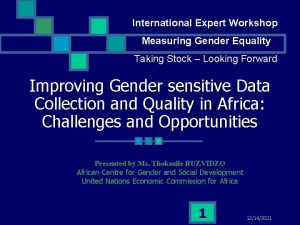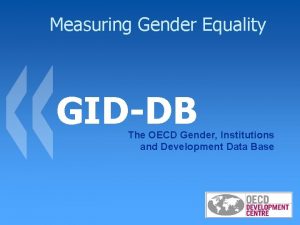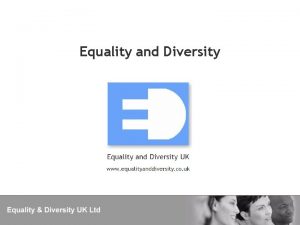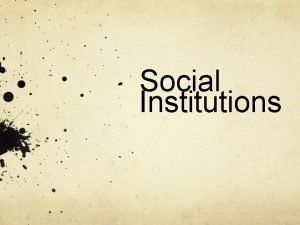Gender Equality and Social Institutions International Expert Workshop















- Slides: 15

Gender Equality and Social Institutions International Expert Workshop Measuring Gender Equality – Taking Stock, Looking Forward OECD Development Centre Paris, 24 -25 May 2007

Presentation Overview I Measuring Gender Equality: Why focus on social institutions? II A new tool: The Gender, Institutions and Development Database (GID) III Conclusions and Outlook

Measuring Gender Equality: Why Focus on Social Institutions? • Social Institutions include norms, traditions and family law • Important impact on the well-being of women and the long-term growth prospects of countries • May arguably be the most important determinants of gender equality – they have generally been in existence for centuries – are extremely difficult to change – and frequently override formal laws and regulations

How do Social Institutions Fit in? SOCIAL INSTITUTIONS iti ad Tr Fa s on mi n tio a n cip rti nity patio a i c P ortu artic i p p om p on nd O force c E a ur o lab. e. g ly L aw Po liti ca e. g l Em. vo pow ting er rig men hts t, Gender Equality Re lig He al e. g th an. lif d e e Sur xpe viv cta al, ncy iou s. P rac tic Source: Own illustration es nt me n i a Att ates l a r ion racy t a ite uc Ed e. g. l s c So ia rm o l. N

The Gender, Institutions and Development Database • A new tool for researchers and policy makers to: – – quantify and measure gender equality compare the status of women across countries build indicators of gender equality analyse obstacles to women’s socio-economic development • Covers 161 countries and has 60 indicators • Includes institutional variables that range from intra-household behaviour to social norms

GID-Indicators: Social Institutions Family Code Physical Integrity Civil Liberties Ownership Rights MEASUREMENT • Marriage before the age of 20 • Acceptance of polygamy within a society • Parental authority granted to father and mother equally • Inheritance practices in favour of male heirs • Prevalence of female genital mutilation • Missing Women • Legislation punishing acts of violence against women • Freedom of movement • Obligation to wear a veil in public • Women’s access to land ownership • Women’s access to bank loans • Women’s access to property other than land 0 = NO DISCRIMINATION to 1 = HIGH DISCRIMINATION

Social institutions affect the level of female employment… Source: Gender, Institutions and Development Data Base

…and women’s educational attainment Source: Gender, Institutions and Development Data Base

Family Code Marriage before the age of 20 • early marriage a good proxy of the percentage of forced marriages; reliable data • not pertinent when many couples are not married; pressure of parents may also have disappeared Acceptance of polygamy within a society • interesting variable as it reveals important gender inequality • information less satisfactory if polygamy is not legal but practised according to custom ADDITIONAL VARIABLES • The percentage of married men engaged in polygamous unions • Repudiation/divorce procedures: divorce main factor of poverty for women • Percentage of women between 15 -19 years who are mothers or pregnant

Family Code Parental authority (parental authority during marriage and custody of children after divorce) • usually very brief information; need to systematically collect data on custody • In some OECD countries, the mother alone has nearly always Q custody of the children: is it equal or unequal? Inheritance (equality between daughters and sons, or between widows and their husband’s family when there is no child) • Information about the first aspect is nearly always available, but not about the second, which should be monitored closer PROBLEM • Both aspects are linked to the access of women to land property. When access is limited to men, inequality concerning inheritance among peasants is not an independent variable.

Physical Integrity Prevalence of female genital mutilation • clearly a form of violence against women, fairly reliable information • concerns only certain regions Missing women • clear form of violence; demographic statistics provide reliable information; analysed in-depth by S. Klasen et al. • link between sex ratio and violence against women not always conclusive Legislations punishing acts of violence against women • data available and homogeneous in a very large number of countries • weak correlation between the legislation and the frequency of acts of violence against women ADDITIONAL VARIABLES • Acceptance of violence by women: high correlation with frequency of violence, but data only provided for less than 40 countries • Percentage of women killed by their husband: clear form of violence, but only available for less than 50 countries

Civil Liberties Obligation to wear a veil in public • often the sign of a life in a state of submission • situation is only clear in countries in which no woman or all women wear a veil Q • Does a frequency below 100% mean anything as regards obligation? Freedom of movement • direct incidence on women’ participation to economy • no precise and reliable sources, mostly qualitative information; need for quantitative data ADDITIONAL VARIABLES • application for a passport without the permission of the husband • ratio of women who are member of an association compared to the ratio of men who are a member

Ownership Rights Women’s access to land property • Property, especially land ownership in developing countries, the basis of economic activity; clear indication of women’s exclusion Women’s access to non-land-assets • No satisfactory information for cases in which custom – not law – requires women to demand the approval of their husband prior to ownership Women’s access to credit • Frequently insufficient data on the role of micro-finance institutions ADDITIONAL VARIABLES • (In)equalities in business contracting (according to laws and in practice)

Two Proposals for Additional Variables 1) The image of women in the media, in (school) textbooks and value judgments/opinions • Interest: the image and the value judgments are correlated with the status of women • Basic information available, but more details must be collected • The World Value Surveys contains many useful questions about value judgment 2) The relationship between economic activity and parenthood • Concerns OECD countries as well as the formal sector of developing countries. • Without monetary subsidies or accessible child care facilities, very difficult for women to keep their job while raising young children • Sources concerning these measures exist (cf. ILO studies, UE statistics)

Conclusions and Outlook • Gender equality is key to development • Social institutions have so far been largely overlooked – research should better analyse their role – so that policies can address them effectively • Outlook – Improve the GID-DB – Revise existing indicators – Exchange experiences on measurements of gender equality (e. g. International Expert Meetings) – Collaborate with other international organisations
 Strategic gender needs and practical gender needs
Strategic gender needs and practical gender needs Gender equality is more than a goal in itself
Gender equality is more than a goal in itself Rhetorical questions about gender equality
Rhetorical questions about gender equality Gender equality definition
Gender equality definition What is gender equality answer
What is gender equality answer Methodology of gender equality
Methodology of gender equality Aims of kothari commission 1964-66
Aims of kothari commission 1964-66 Poem about gender discrimination
Poem about gender discrimination Example of gender equality
Example of gender equality Gender equality slogan
Gender equality slogan Gender inequality case study
Gender inequality case study Formal and substantive equality
Formal and substantive equality Formal and substantive equality
Formal and substantive equality Transformation of culture and social institutions over time
Transformation of culture and social institutions over time Gender stratified
Gender stratified Tax expert international ag
Tax expert international ag

